Design and Manipulation of Ferroic Domains in Complex Oxide Heterostructures
Abstract
1. Introduction
2. Controlled Ferroelectric and Multiferroic Domain Architectures in Thin Films
2.1. Domain State and Domain Wall Engineering in Ferroelectric Thin Films
2.2. Engineering Multiferroic Domains in Thin Films
2.3. Domain Pattern Transfer in Artificial Multiferroic Heterostructures
3. Accessing the Domain State in Ferroic Multilayers
3.1. Probing Buried Polarization States (Invasive)
3.1.1. Scanning Transmission Electron Microscopy (STEM)
3.1.2. Time of Flight Secondary Ion Mass Spectrometry (TOF-SIMS)
3.1.3. Piezoresponse Force Microscopy (PFM)
3.2. Non-Invasive Probe of Buried Ferroelectric Domains
3.2.1. X-Ray Diffraction
3.2.2. Optical Second Harmonic Generation (SHG)
3.3. Probing Magnetic Domain Architectures (Non-Invasive)
3.3.1. Magnetic Force Microscopy (MFM)
3.3.2. Single Spin Magnetometry
3.3.3. Optical SHG
4. Switching Events in Multiferroics
4.1. Imaging a Multiferroic Magnetoelectric Switch
4.2. Controlling Domain Dynamics
4.3. Evolution of Magnetoelectric Coupling in Artificial Multiferroic Heterostructures
5. Conclusions and Perspective
Funding
Acknowledgments
Conflicts of Interest
References
- Trassin, M. Low energy consumption spintronics using multiferroic heterostructures. J. Phys. Condens. Matter 2016, 28, 033001. [Google Scholar] [CrossRef] [PubMed]
- Spaldin, N.A.; Fiebig, M. The renaissance of magnetoelectric multiferroics. Science 2005, 309, 391–392. [Google Scholar] [CrossRef] [PubMed]
- Spaldin, N.A.; Ramesh, R. Advances in magnetoelectric multiferroics. Nat. Mater. 2019, 18, 203–212. [Google Scholar] [CrossRef] [PubMed]
- Tian, G.; Yang, W.; Chen, D.; Fan, Z.; Hou, Z.; Alexe, M.; Gao, X. Topological domain states and magnetoelectric properties in multiferroic nanostructures. Natl. Sci. Rev. 2019, 6, 684–702. [Google Scholar] [CrossRef]
- Gajek, M.; Bibes, M.; Fusil, S.; Bouzehouane, K.; Fontcuberta, J.; Barthélémy, A.; Fert, A. Tunnel junctions with multiferroic barriers. Nat. Mater. 2007, 6, 296–302. [Google Scholar] [CrossRef] [PubMed]
- Scott, J.F. Multiferroic memories. Nat. Mater. 2007, 6, 256–257. [Google Scholar] [CrossRef] [PubMed]
- Bibes, M.; Barthélémy, A. Towards a magnetoelectric memory. Nat. Mater. 2008, 7, 425–426. [Google Scholar] [CrossRef] [PubMed]
- Fiebig, M. Revival of the magnetoelectric effect. J. Phys. D. Appl. Phys. 2005, 38, 123–152. [Google Scholar] [CrossRef]
- Yu, P.; Chu, Y.-H.; Ramesh, R. Oxide interfaces: Pathways to novel phenomena. Mater. Today 2012, 15, 320–327. [Google Scholar] [CrossRef]
- Ionescu, A.M. Nanoelectronics: Ferroelectric devices show potential. Nat. Nanotechnol. 2012, 7, 83–85. [Google Scholar] [CrossRef]
- Zhuravlev, M.Y.; Sabirianov, R.F.; Jaswal, S.S.; Tsymbal, E.Y. Giant Electroresistance in Ferroelectric Tunnel Junctions. Phys. Rev. Lett. 2005, 94, 246802. [Google Scholar] [CrossRef]
- Nagarajan, V.; Roytburd, A.; Stanishevsky, A.; Prasertchoung, S.; Zhao, T.; Chen, L.; Melngailis, J.; Auciello, O.; Ramesh, R. Dynamics of ferroelastic domains in ferroelectric thin films. Nat. Mater. 2003, 2, 43–47. [Google Scholar] [CrossRef] [PubMed]
- Jiang, A.Q.; Meng, X.J.; Zhang, D.W.; Park, M.H.; Yoo, S.; Kim, Y.J.; Scott, J.F.; Hwang, C.S. Giant dielectric permittivity in ferroelectric thin films: Domain wall ping pong. Sci. Rep. 2015, 5, 14618. [Google Scholar] [CrossRef] [PubMed]
- Zubko, P.; Wojdeł, J.C.; Hadjimichael, M.; Fernandez-Pena, S.; Sené, A.; Luk’yanchuk, I.; Triscone, J.-M.; Íñiguez, J. Negative capacitance in multidomain ferroelectric superlattices. Nature 2016, 534, 524–528. [Google Scholar] [CrossRef] [PubMed]
- Yadav, A.K.; Nguyen, K.X.; Hong, Z.; García-Fernández, P.; Aguado-Puente, P.; Nelson, C.T.; Das, S.; Prasad, B.; Kwon, D.; Cheema, S.; et al. Spatially resolved steady-state negative capacitance. Nature 2019, 565, 468–471. [Google Scholar] [CrossRef]
- Sanchez-Santolino, G.; Tornos, J.; Hernandez-Martin, D.; Beltran, J.I.; Munuera, C.; Cabero, M.; Perez-Muñoz, A.; Ricote, J.; Mompean, F.; Garcia-Hernandez, M.; et al. Resonant electron tunnelling assisted by charged domain walls in multiferroic tunnel junctions. Nat. Nanotechnol. 2017, 12, 655. [Google Scholar] [CrossRef] [PubMed]
- Leo, N.; Carolus, V.; White, J.S.; Kenzelmann, M.; Hudl, M.; Tolédano, P.; Honda, T.; Kimura, T.; Ivanov, S.A.; Weil, M.; et al. Magnetoelectric inversion of domain patterns. Nature 2018, 560, 466–470. [Google Scholar] [CrossRef]
- Meier, D. Functional domain walls in multiferroics. J. Phys. Condens. Matter. 2015, 27, 463003. [Google Scholar] [CrossRef]
- Catalan, G.; Seidel, J.; Ramesh, R.; Scott, J.F. Domain wall nanoelectronics. Rev. Mod. Phys. 2012, 84, 119–156. [Google Scholar] [CrossRef]
- Wei, X.-K.; Tagantsev, A.K.; Kvasov, A.; Roleder, K.; Jia, C.-L.; Setter, N. Ferroelectric translational antiphase boundaries in nonpolar materials. Nat. Commun. 2014, 5, 3031. [Google Scholar] [CrossRef]
- Farokhipoor, S.; Magén, C.; Venkatesan, S.; Íñiguez, J.; Daumont, C.J.M.; Rubi, D.; Snoeck, E.; Mostovoy, M.; de Graaf, C.; Müller, A.; et al. Artificial chemical and magnetic structure at the domain walls of an epitaxial oxide. Nature 2014, 515, 379–383. [Google Scholar] [CrossRef] [PubMed]
- Hassanpour, E.; Weber, M.C.; Bortis, A.; Tokunaga, Y.; Taguchi, Y.; Tokura, Y.; Cano, A.; Lottermoser, T.; Fiebig, M. Interconversion of multiferroic domains and domain walls. arXiv 2019, arXiv:1908.06876. [Google Scholar]
- Allibe, J.; Fusil, S.; Bouzehouane, K.; Daumont, C.; Sando, D.; Jacquet, E.; Deranlot, C.; Bibes, M.; Barthélémy, A. Room Temperature Electrical Manipulation of Giant Magnetoresistance in Spin Valves Exchange-Biased with BiFeO3. Nano Lett. 2012, 12, 1141–1145. [Google Scholar] [CrossRef] [PubMed]
- Seidel, J.; Martin, L.W.; He, Q.; Zhan, Q.; Chu, Y.-H.; Rother, A.; Hawkridge, M.E.; Maksymovych, P.; Yu, P.; Gajek, M.; et al. Conduction at domain walls in oxide multiferroics. Nat. Mater. 2009, 8, 229–234. [Google Scholar] [CrossRef] [PubMed]
- Guyonnet, J.; Gaponenko, I.; Gariglio, S.; Paruch, P. Conduction at Domain Walls in Insulating Pb(Zr0.2Ti0.8)O3 Thin Films. Adv. Mater. 2011, 23, 5377–5382. [Google Scholar] [CrossRef] [PubMed]
- Yang, S.Y.; Seidel, J.; Byrnes, S.J.; Shafer, P.; Yang, C.-H.; Rossell, M.D.; Yu, P.; Chu, Y.-H.; Scott, J.F.; Ager III, J.W.; et al. Above-bandgap voltages from ferroelectric photovoltaic devices. Nat. Nanotechnol. 2010, 5, 143. [Google Scholar] [CrossRef] [PubMed]
- Schlom, D.G.; Chen, L.-Q.; Eom, C.-B.; Rabe, K.M.; Streiffer, S.K.; Triscone, J.-M. Strain tuning of ferroelectric thin films. Annu. Rev. Mater. Res. 2007, 37, 589–626. [Google Scholar] [CrossRef]
- Matzen, S.; Fusil, S. Domains and domain walls in multiferroics. Comptes Rendus Phys. 2015, 16, 227–240. [Google Scholar] [CrossRef]
- Lu, H.; Liu, X.; Burton, J.D.; Bark, C.-W.; Wang, Y.; Zhang, Y.; Kim, D.J.; Stamm, A.; Lukashev, P.; Felker, D.A.; et al. Enhancement of ferroelectric polarization stability by interface engineering. Adv. Mater. 2012, 24, 1209–1216. [Google Scholar] [CrossRef]
- Yu, P.; Luo, W.; Yi, D.; Zhang, J.X.; Rossell, M.D.; Yang, C.-H.; You, L.; Singh-Bhalla, G.; Yang, S.Y.; He, Q.; et al. Interface control of bulk ferroelectric polarization. Proc. Natl. Acad. Sci. 2012, 109, 9710–9715. [Google Scholar] [CrossRef]
- Fong, D.D.; Kolpak, A.M.; Eastman, J.A.; Streiffer, S.K.; Fuoss, P.H.; Stephenson, G.B.; Thompson, C.; Kim, D.M.; Choi, K.J.; Eom, C.B.; et al. Stabilization of Monodomain Polarization in Ultrathin PbTiO3 Films. Phys. Rev. Lett. 2006, 96, 127601. [Google Scholar] [CrossRef] [PubMed]
- Highland, M.J.; Fister, T.T.; Richard, M.-I.; Fong, D.D.; Fuoss, P.H.; Thompson, C.; Eastman, J.A.; Streiffer, S.K.; Stephenson, G.B. Polarization Switching without Domain Formation at the Intrinsic Coercive Field in Ultrathin Ferroelectric PbTiO3. Phys. Rev. Lett. 2010, 105, 167601. [Google Scholar] [CrossRef] [PubMed]
- Solmaz, A.; Huijben, M.; Koster, G.; Egoavil, R.; Gauquelin, N.; Van Tendeloo, G.; Verbeeck, J.; Noheda, B.; Rijnders, G. Domain Selectivity in BiFeO3 Thin Films by Modified Substrate Termination. Adv. Funct. Mater. 2016, 26, 2882–2889. [Google Scholar] [CrossRef]
- Lichtensteiger, C.; Fernandez-Pena, S.; Weymann, C.; Zubko, P.; Triscone, J.M. Tuning of the depolarization field and nanodomain structure in ferroelectric thin films. Nano Lett. 2014, 14, 4205–4211. [Google Scholar] [CrossRef] [PubMed]
- Strkalj, N.; De Luca, G.; Campanini, M.; Pal, S.; Schaab, J.; Gattinoni, C.; Spaldin, N.A.; Rossell, M.D.; Fiebig, M.; Trassin, M. Depolarizing Field Effects in Epitaxial Capacitor Heterostructures. Phys. Rev. Lett. 2019, in press. [Google Scholar]
- Jia, C.-L.; Nagarajan, V.; He, J.-Q.; Houben, L.; Zhao, T.; Ramesh, R.; Urban, K.; Waser, R. Unit-cell scale mapping of ferroelectricity and tetragonality in epitaxial ultrathin ferroelectric films. Nat. Mater. 2007, 6, 64–69. [Google Scholar] [CrossRef]
- Zubko, P.; Lu, H.; Bark, C.-W.; Martí, X.; Santiso, J.; Eom, C.-B.; Catalan, G.; Gruverman, A. On the persistence of polar domains in ultrathin ferroelectric capacitors. J. Phys. Condens. Matter 2017, 29, 284001. [Google Scholar] [CrossRef]
- Liu, G.; Chen, J.; Lichtensteiger, C.; Triscone, J.-M.; Aguado-Puente, P.; Junquera, J.; Valanoor, N. Positive Effect of an Internal Depolarization Field in Ultrathin Epitaxial Ferroelectric Films. Adv. Electron. Mater. 2016, 2, 1500288. [Google Scholar] [CrossRef]
- Chu, Y.-H.; Cruz, M.P.; Yang, C.-H.; Martin, L.W.; Yang, P.-L.; Zhang, J.-X.; Lee, K.; Yu, P.; Chen, L.-Q.; Ramesh, R. Domain Control in Multiferroic BiFeO3 through Substrate Vicinality. Adv. Mater. 2007, 19, 2662–2666. [Google Scholar] [CrossRef]
- Chu, Y.-H.; He, Q.; Yang, C.-H.; Yu, P.; Martin, L.W.; Shafer, P.; Ramesh, R. Nanoscale Control of Domain Architectures in BiFeO3 Thin Films. Nano Lett. 2009, 9, 1726–1730. [Google Scholar] [CrossRef]
- Trassin, M.; Clarkson, J.D.; Bowden, S.R.; Liu, J.; Heron, J.T.; Paull, R.J.; Arenholz, E.; Pierce, D.T.; Unguris, J. Interfacial coupling in multiferroic/ferromagnet heterostructures. Phys. Rev. B 2013, 87, 134426. [Google Scholar] [CrossRef]
- Chen, D.; Chen, Z.; He, Q.; Clarkson, J.D.; Serrao, C.R.; Yadav, A.K.; Nowakowski, M.E.; Fan, Z.; You, L.; Gao, X.; et al. Interface Engineering of Domain Structures in BiFeO3 Thin Films. Nano Lett. 2017, 17, 486–493. [Google Scholar] [CrossRef] [PubMed]
- Nelson, C.T.; Winchester, B.; Zhang, Y.; Kim, S.-J.; Melville, A.; Adamo, C.; Folkman, C.M.; Baek, S.-H.; Eom, C.-B.; Schlom, D.G.; et al. Spontaneous Vortex Nanodomain Arrays at Ferroelectric Heterointerfaces. Nano Lett. 2011, 11, 828–834. [Google Scholar] [CrossRef] [PubMed]
- Folkman, C.M.; Baek, S.H.; Jang, H.W.; Eom, C.B.; Nelson, C.T.; Pan, X.Q.; Li, Y.L.; Chen, L.Q.; Kumar, A.; Gopalan, V.; et al. Stripe domain structure in epitaxial (001) BiFeO3 thin films on orthorhombic TbScO3 substrate. Appl. Phys. Lett. 2009, 94, 251911. [Google Scholar] [CrossRef]
- Li, L.; Cheng, X.; Jokisaari, J.R.; Gao, P.; Britson, J.; Adamo, C.; Heikes, C.; Schlom, D.G.; Chen, L.-Q.; Pan, X. Defect-Induced Hedgehog Polarization States in Multiferroics. Phys. Rev. Lett. 2018, 120, 137602. [Google Scholar] [CrossRef] [PubMed]
- Li, L.; Zhang, Y.; Xie, L.; Jokisaari, J.R.; Beekman, C.; Yang, J.-C.; Chu, Y.-H.; Christen, H.M.; Pan, X. Atomic-Scale Mechanisms of Defect-Induced Retention Failure in Ferroelectrics. Nano Lett. 2017, 17, 3556–3562. [Google Scholar] [CrossRef] [PubMed]
- Li, L.; Jokisaari, J.R.; Zhang, Y.; Cheng, X.; Yan, X.; Heikes, C.; Lin, Q.; Gadre, C.; Schlom, D.G.; Chen, L.-Q.; et al. Control of Domain Structures in Multiferroic Thin Films through Defect Engineering. Adv. Mater. 2018, 30, 1802737. [Google Scholar] [CrossRef] [PubMed]
- Fiebig, M.; Lottermoser, T.; Meier, D.; Trassin, M. The evolution of multiferroics. Nat. Rev. Mater. 2016, 1, 16046. [Google Scholar] [CrossRef]
- Wang, J.; Neaton, J.B.; Zheng, H.; Nagarajan, V.; Ogale, S.B.; Liu, B.; Viehland, D.; Vaithyanathan, V.; Schlom, D.G.; Waghmare, U.V.; et al. Epitaxial BiFeO3 Multiferroic Thin Film Heterostructures. Science 2003, 299, 1719–1722. [Google Scholar] [CrossRef]
- Fiebig, M.; Lottermoser, T.; Fröhlich, D.; Goltsev, A.V.; Pisarev, R.V. Observation of coupled magnetic and electric domains. Nature 2002, 419, 818–820. [Google Scholar] [CrossRef]
- Geng, Y.; Lee, N.; Choi, Y.J.; Cheong, S.-W.; Wu, W. Collective Magnetism at Multiferroic Vortex Domain Walls. Nano Lett. 2012, 12, 6055–6059. [Google Scholar] [CrossRef] [PubMed]
- Kimura, T.; Goto, T.; Shintani, H.; Ishizaka, K.; Arima, T.; Tokura, Y. Magnetic control of ferroelectric polarization. Nature 2003, 426, 55–58. [Google Scholar] [CrossRef] [PubMed]
- Matsubara, M.; Manz, S.; Mochizuki, M.; Kubacka, T.; Iyama, A.; Aliouane, N.; Kimura, T.; Johnson, S.L.; Meier, D.; Fiebig, M. Magnetoelectric domain control in multiferroic TbMnO3. Science 2015, 348, 1112–1115. [Google Scholar] [CrossRef] [PubMed]
- Hur, N.; Park, S.; Sharma, P.A.; Ahn, J.S.; Guha, S.; Cheong, S.-W. Electric polarization reversal and memory in a multiferroic material induced by magnetic fields. Nature 2004, 429, 392–395. [Google Scholar] [CrossRef] [PubMed]
- Heyer, O.; Hollmann, N.; Klassen, I.; Jodlauk, S.; Bohatý, L.; Becker, P.; Mydosh, J.A.; Lorenz, T.; Khomskii, D. A new multiferroic material: MnWO4. J. Phys. Condens. Matter 2006, 18, 471–475. [Google Scholar] [CrossRef]
- Eerenstein, W.; Mathur, N.D.; Scott, J.F. Multiferroic and magnetoelectric materials. Nature 2006, 442, 759–765. [Google Scholar] [CrossRef] [PubMed]
- Cheong, S.-W.; Mostovoy, M. Multiferroics: A magnetic twist for ferroelectricity. Nat. Mater. 2007, 6, 13–20. [Google Scholar] [CrossRef]
- Heron, J.T.; Trassin, M.; Ashraf, K.; Gajek, M.; He, Q.; Yang, S.Y.; Nikonov, D.E.; Chu, Y.-H.; Salahuddin, S.; Ramesh, R. Electric-Field-Induced Magnetization Reversal in a Ferromagnet-Multiferroic Heterostructure. Phys. Rev. Lett. 2011, 107, 217202. [Google Scholar] [CrossRef] [PubMed]
- Heron, J.T.; Bosse, J.L.; He, Q.; Gao, Y.; Trassin, M.; Ye, L.; Clarkson, J.D.; Wang, C.; Liu, J.; Salahuddin, S.; et al. Deterministic switching of ferromagnetism at room temperature using an electric field. Nature 2014, 516, 370–378. [Google Scholar] [CrossRef]
- Sando, D.; Agbelele, A.; Rahmedov, D.; Liu, J.; Rovillain, P.; Toulouse, C.; Infante, I.C.; Pyatakov, A.P.; Fusil, S.; Jacquet, E.; et al. Crafting the magnonic and spintronic response of BiFeO3 films by epitaxial strain. Nat. Mater. 2013, 12, 641–646. [Google Scholar] [CrossRef]
- Rovillain, P.; de Sousa, R.; Gallais, Y.; Sacuto, A.; Méasson, M.A.; Colson, D.; Forget, A.; Bibes, M.; Barthélémy, A.; Cazayous, M. Electric-field control of spin waves at room temperature in multiferroic BiFeO3. Nat. Mater. 2010, 9, 975–979. [Google Scholar] [CrossRef] [PubMed]
- Jungwirth, T.; Marti, X.; Wadley, P.; Wunderlich, J. Antiferromagnetic spintronics. Nat. Nanotechnol. 2016, 11, 231–241. [Google Scholar] [CrossRef] [PubMed]
- Mundy, J.A.; Brooks, C.M.; Holtz, M.E.; Moyer, J.A.; Das, H.; Rébola, A.F.; Heron, J.T.; Clarkson, J.D.; Disseler, S.M.; Liu, Z.; et al. Atomically engineered ferroic layers yield a room-temperature magnetoelectric multiferroic. Nature 2016, 537, 523–527. [Google Scholar] [CrossRef] [PubMed]
- Fernandes Vaz, C.A.; Staub, U. Artificial multiferroic heterostructures. J. Mater. Chem. C 2013, 1, 6731–6742. [Google Scholar] [CrossRef]
- Garcia, V.; Bibes, M.; Barthélémy, A. Artificial multiferroic heterostructures for an electric control of magnetic properties. Comptes Rendus Phys. 2015, 16, 168–181. [Google Scholar] [CrossRef]
- Zavaliche, F.; Zheng, H.; Mohaddes-Ardabili, L.; Yang, S.Y.; Zhan, Q.; Shafer, P.; Reilly, E.; Chopdekar, R.; Jia, Y.; Wright, P.; et al. Electric Field-Induced Magnetization Switching in Epitaxial Columnar Nanostructures. Nano Lett. 2005, 5, 1793–1796. [Google Scholar] [CrossRef] [PubMed]
- Sun, X.; Huang, J.; Jian, J.; Fan, M.; Wang, H.; Li, Q.; Mac Manus-Driscoll, J.L.; Lu, P.; Zhang, X.; Wang, H. Three-dimensional strain engineering in epitaxial vertically aligned nanocomposite thin films with tunable magnetotransport properties. Mater. Horizons 2018, 5, 536–544. [Google Scholar] [CrossRef]
- Wu, R.; Kursumovic, A.; Gao, X.; Yun, C.; Vickers, M.E.; Wang, H.; Cho, S.; MacManus-Driscoll, J.L. Design of a Vertical Composite Thin Film System with Ultralow Leakage to Yield Large Converse Magnetoelectric Effect. ACS Appl. Mater. Interfaces 2018, 10, 18237–18245. [Google Scholar] [CrossRef]
- Chen, A.; Dai, Y.; Eshghinejad, A.; Liu, Z.; Wang, Z.; Bowlan, J.; Knall, E.; Civale, L.; MacManus-Driscoll, J.L.; Taylor, A.J.; et al. Competing Interface and Bulk Effect–Driven Magnetoelectric Coupling in Vertically Aligned Nanocomposites. Adv. Sci. 2019, 1901000. [Google Scholar] [CrossRef]
- Lahtinen, T.H.E.; Franke, K.J.A.; van Dijken, S. Electric-field control of magnetic domain wall motion and local magnetization reversal. Sci. Rep. 2012, 2, 258. [Google Scholar] [CrossRef]
- Chopdekar, R.V.; Malik, V.K.; Fraile Rodríguez, A.; Le Guyader, L.; Takamura, Y.; Scholl, A.; Stender, D.; Schneider, C.W.; Bernhard, C.; Nolting, F.; et al. Spatially resolved strain-imprinted magnetic states in an artificial multiferroic. Phys. Rev. B 2012, 86, 014408. [Google Scholar] [CrossRef]
- Lahtinen, T.H.E.; Tuomi, J.O.; Van Dijken, S. Pattern transfer and electric-field-induced magnetic domain formation in multiferroic heterostructures. Adv. Mater. 2011, 23, 3187–3191. [Google Scholar] [CrossRef] [PubMed]
- Brandl, F.; Franke, K.J.A.; Lahtinen, T.H.E.; Van Dijken, S.; Grundler, D. Spin waves in CoFeB on ferroelectric domains combining spin mechanics and magnonics. Solid State Commun. 2014, 198, 13–17. [Google Scholar] [CrossRef][Green Version]
- Wang, J.; Pesquera, D.; Mansell, R.; van Dijken, S.; Cowburn, R.P.; Ghidini, M.; Mathur, N.D. Giant non-volatile magnetoelectric effects via growth anisotropy in Co40Fe40B20 films on PMN-PT substrates. Appl. Phys. Lett. 2019, 114, 92401. [Google Scholar] [CrossRef]
- Lahtinen, T.H.E.; Shirahata, Y.; Yao, L.; Franke, K.J.A.; Venkataiah, G.; Taniyama, T.; Van Dijken, S. Alternating domains with uniaxial and biaxial magnetic anisotropy in epitaxial Fe films on BaTiO3. Appl. Phys. Lett. 2012, 101, 262405. [Google Scholar] [CrossRef]
- You, L.; Wang, B.; Zou, X.; Lim, Z.S.; Zhou, Y.; Ding, H.; Chen, L.; Wang, J. Origin of the uniaxial magnetic anisotropy in La0.7Sr0.3MnO3 on stripe-domain BiFeO3. Phys. Rev. B 2013, 88, 184426. [Google Scholar] [CrossRef]
- Streubel, R.; Köhler, D.; Schäfer, R.; Eng, L.M. Strain-mediated elastic coupling in magnetoelectric nickel/barium-titanate heterostructures. Phys. Rev. B 2013, 87, 054410. [Google Scholar] [CrossRef]
- Fackler, S.W.; Donahue, M.J.; Gao, T.; Nero, P.N.A.; Cheong, S.-W.; Cumings, J.; Takeuchi, I. Local control of magnetic anisotropy in transcritical permalloy thin films using ferroelectric BaTiO3 domains. Appl. Phys. Lett. 2014, 105, 212905. [Google Scholar] [CrossRef]
- Franke, K.J.A.; Lahtinen, T.H.E.; Van Dijken, S. Field tuning of ferromagnetic domain walls on elastically coupled ferroelectric domain boundaries. Phys. Rev. B 2012, 85, 094423. [Google Scholar] [CrossRef]
- Cybart, S.A.; Rossell, M.D.; Wu, S.M.; Zhang, J.X.; Yu, P.; Ramesh, R.; Dynes, R.C. Reversible electric control of exchange bias in a multiferroic field-effect device. Nat. Mater. 2010, 9, 756–761. [Google Scholar]
- Lebeugle, D.; Mougin, A.; Viret, M.; Colson, D.; Ranno, L. Electric Field Switching of the Magnetic Anisotropy of a Ferromagnetic Layer Exchange Coupled to the Multiferroic Compound BiFeO3. Phys. Rev. Lett. 2009, 103, 257601. [Google Scholar] [CrossRef] [PubMed]
- Kim, S.-H.; Choi, H.; No, K.; Shin, S.-C. Electric-field induced ferromagnetic domain changes in exchange biased Co–BiFeO3 composites. J. Phys. D. Appl. Phys. 2010, 43, 165001. [Google Scholar] [CrossRef]
- Laukhin, V.; Skumryev, V.; Martí, X.; Hrabovsky, D.; Sánchez, F.; García-Cuenca, M.V.; Ferrater, C.; Varela, M.; Lüders, U.; Bobo, J.F.; et al. Electric-field control of exchange bias in multiferroic epitaxial heterostructures. Phys. Rev. Lett. 2006, 97, 227201. [Google Scholar] [CrossRef] [PubMed]
- Skumryev, V.; Laukhin, V.; Fina, I.; Martí, X.; Sánchez, F.; Gospodinov, M.; Fontcuberta, J. Magnetization reversal by electric-field decoupling of magnetic and ferroelectric domain walls in multiferroic-based heterostructures. Phys. Rev. Lett. 2011, 106, 057206. [Google Scholar] [CrossRef]
- Hong, X.; Posadas, A.; Ahn, C.H. Examining the screening limit of field effect devices via the metal-insulator transition. Appl. Phys. Lett. 2005, 86, 142501. [Google Scholar] [CrossRef]
- Molegraaf, H.J.A.; Hoffman, J.; Vaz, C.A.F.; Gariglio, S.; Van Der Morel, D.; Ahn, C.H.; Triscone, J.M. Magnetoelectric effects in complex oxides with competing ground states. Adv. Mater. 2009, 21, 3470–3474. [Google Scholar] [CrossRef]
- Vaz, C.A.F.; Hoffman, J.; Segal, Y.; Reiner, J.W.; Grober, R.D.; Zhang, Z.; Ahn, C.H.; Walker, F.J. Origin of the magnetoelectric coupling effect in Pb(Zr0.2Ti0.8)O3 /La0.8Sr0.2MnO3 multiferroic heterostructures. Phys. Rev. Lett. 2010, 104, 127202. [Google Scholar] [CrossRef] [PubMed]
- Brivio, S.; Cantoni, M.; Petti, D.; Bertacco, R. Near-room-temperature control of magnetization in field effect devices based on La0.67Sr0.33MnO3 thin films. J. Appl. Phys. 2010, 108, 113906. [Google Scholar] [CrossRef]
- Duan, C.-G.; Jaswal, S.S.; Tsymbal, E.Y. Predicted Magnetoelectric Effect in Fe/BaTiO3 Multilayers: Ferroelectric Control of Magnetism. Phys. Rev. Lett. 2006, 97, 47201. [Google Scholar] [CrossRef] [PubMed]
- Cai, T.; Ju, S.; Lee, J.; Sai, N.; Demkov, A.A.; Niu, Q.; Li, Z.; Shi, J.; Wang, E. Magnetoelectric coupling and electric control of magnetization in ferromagnet/ferroelectric/normal-metal superlattices. Phys. Rev. B 2009, 80, 140415. [Google Scholar] [CrossRef]
- Rondinelli, J.M.; Stengel, M.; Spaldin, N.A. Carrier-mediated magnetoelectricity in complex oxide heterostructures. Nat. Nanotechnol. 2007, 3, 46–50. [Google Scholar] [CrossRef] [PubMed]
- Nordlander, J.; De Luca, G.; Strkalj, N.; Fiebig, M.; Trassin, M. Probing Ferroic States in Oxide Thin Films Using Optical Second Harmonic Generation. Appl. Sci. 2018, 8, 570. [Google Scholar] [CrossRef]
- De Luca, G.; Schoenherr, P.; Mendil, J.; Meier, D.; Fiebig, M.; Trassin, M. Domain-Pattern Transfer across an Artificial Magnetoelectric Interface. Phys. Rev. Appl. 2018, 10, 054030. [Google Scholar] [CrossRef]
- Domingo, N.; Gaponenko, I.; Cordero-Edwards, K.; Stucki, N.; Perez Dieste, V.; Escudero, C.; Pach, E.; Verdaguer, A.; Patrycja, P. Surface Charged Species and Electrochemistry of Ferroelectric Thin Films. Nanoscale 2019. [Google Scholar] [CrossRef]
- Mendil, J.; Trassin, M.; Bu, Q.; Schaab, J.; Baumgartner, M.; Murer, C.; Dao, P.T.; Vijayakumar, J.; Bracher, D.; Bouillet, C.; et al. Magnetic properties and domain structure of ultrathin yttrium iron garnet/Pt bilayers. Phys. Rev. Mater. 2019, 3, 34403. [Google Scholar] [CrossRef]
- Bang, A.D.; Olsen, F.K.; Slöetjes, S.D.; Scholl, A.; Retterer, S.T.; Vaz, C.A.F.; Tybell, T.; Folven, E.; Grepstad, J.K. Magnetic domain formation in ultrathin complex oxide ferromagnetic/antiferromagnetic bilayers. Appl. Phys. Lett. 2018, 113, 132402. [Google Scholar] [CrossRef]
- Snoeck, E.; Lubk, A.; Magén, C. Structural Characterization of Ferroelectric and Multiferroic Nanostructures by Advanced TEM Techniques; Wiley Online Books: Hoboken, NJ, USA, 2016; ISBN 9781118935743. [Google Scholar]
- Tang, Y.L.; Zhu, Y.L.; Ma, X.L.; Borisevich, A.Y.; Morozovska, A.N.; Eliseev, E.A.; Wang, W.Y.; Wang, Y.J.; Xu, Y.B.; Zhang, Z.D.; et al. Observation of a periodic array of flux-closure quadrants in strained ferroelectric PbTiO3 films. Science 2015, 348, 547–551. [Google Scholar] [CrossRef]
- De Luca, G.; Rossell, M.D.; Schaab, J.; Viart, N.; Fiebig, M.; Trassin, M. Domain Wall Architecture in Tetragonal Ferroelectric Thin Films. Adv. Mater. 2017, 29, 1605145. [Google Scholar] [CrossRef]
- Yadav, A.K.; Nelson, C.T.; Hsu, S.L.; Hong, Z.; Clarkson, J.D.; Schlepüetz, C.M.; Damodaran, A.R.; Shafer, P.; Arenholz, E.; Dedon, L.R.; et al. Observation of polar vortices in oxide superlattices. Nature 2016, 530, 198–201. [Google Scholar] [CrossRef]
- Das, S.; Tang, Y.L.; Hong, Z.; Gonçalves, M.A.P.; McCarter, M.R.; Klewe, C.; Nguyen, K.X.; Gómez-Ortiz, F.; Shafer, P.; Arenholz, E.; et al. Observation of room-temperature polar skyrmions. Nature 2019, 568, 368–372. [Google Scholar] [CrossRef]
- Lubk, A.; Zweck, J. Differential phase contrast: An integral perspective. Phys. Rev. A 2015, 91, 23805. [Google Scholar] [CrossRef]
- Campanini, M.; Trassin, M.; Ederer, C.; Erni, R.; Rossell, M.D. Buried In-Plane Ferroelectric Domains in Fe-Doped Single-Crystalline Aurivillius Thin Films. ACS Appl. Electron. Mater. 2019, 1, 1019–1028. [Google Scholar] [CrossRef]
- Ievlev, A.V.; Maksymovych, P.; Trassin, M.; Seidel, J.; Ramesh, R.; Kalinin, S.V.; Ovchinnikova, O.S. Chemical State Evolution in Ferroelectric Films during Tip-Induced Polarization and Electroresistive Switching. ACS Appl. Mater. Interfaces 2016, 8, 29588–29593. [Google Scholar] [CrossRef] [PubMed]
- Yang, S.M.; Morozovska, A.N.; Kumar, R.; Eliseev, E.A.; Cao, Y.; Mazet, L.; Balke, N.; Jesse, S.; Vasudevan, R.K.; Dubourdieu, C.; et al. Mixed electrochemical–ferroelectric states in nanoscale ferroelectrics. Nat. Phys. 2017, 13, 812–818. [Google Scholar] [CrossRef]
- Gruverman, A.; Alexe, M.; Meier, D. Piezoresponse force microscopy and nanoferroic phenomena. Nat. Commun. 2019, 10, 1661. [Google Scholar] [CrossRef] [PubMed]
- Steffes, J.J.; Ristau, R.A.; Ramesh, R.; Huey, B.D. Thickness scaling of ferroelectricity in BiFeO3 by tomographic atomic force microscopy. Proc. Natl. Acad. Sci. USA 2019, 116, 2413–2418. [Google Scholar] [CrossRef] [PubMed]
- Lu, H.; Bark, C.-W.; Esque de los Ojos, D.; Alcala, J.; Eom, C.B.; Catalan, G.; Gruverman, A. Mechanical Writing of Ferroelectric Polarization. Science 2012, 336, 59–61. [Google Scholar] [CrossRef] [PubMed]
- Streiffer, S.K.; Eastman, J.A.; Fong, D.D.; Thompson, C.; Munkholm, A.; Ramana Murty, M.V.; Auciello, O.; Bai, G.R.; Stephenson, G.B. Observation of Nanoscale 180° Stripe Domains in Ferroelectric PbTiO3 Thin Films. Phys. Rev. Lett. 2002, 89, 67601. [Google Scholar] [CrossRef] [PubMed]
- Zubko, P.; Jecklin, N.; Stucki, N.; Lichtensteiger, C.; Rispens, G.; Triscone, J.-M. Ferroelectric Domains in PbTiO3/SrTiO3 Superlattices. Ferroelectrics 2012, 433, 127–137. [Google Scholar] [CrossRef]
- Dawber, M.; Stucki, N.; Lichtensteiger, C.; Ganglio, S.; Ghosez, P.; Triscone, J.M. Tailoring the properties of artificially layered ferroelectric superlattices. Adv. Mater. 2007, 19, 4153–4159. [Google Scholar] [CrossRef]
- Zubko, P.; Jecklin, N.; Torres-Pardo, A.; Aguado-Puente, P.; Gloter, A.; Lichtensteiger, C.; Junquera, J.; Stéphan, O.; Triscone, J.-M. Electrostatic Coupling and Local Structural Distortions at Interfaces in Ferroelectric/Paraelectric Superlattices. Nano Lett. 2012, 12, 2846–2851. [Google Scholar] [CrossRef] [PubMed]
- Jo, J.Y.; Chen, P.; Sichel, R.J.; Callori, S.J.; Sinsheimer, J.; Dufresne, E.M.; Dawber, M.; Evans, P.G. Nanosecond Dynamics of Ferroelectric/Dielectric Superlattices. Phys. Rev. Lett. 2011, 107, 55501. [Google Scholar] [CrossRef] [PubMed]
- Zubko, P.; Stucki, N.; Lichtensteiger, C.; Triscone, J.-M. X-Ray Diffraction Studies of 180° Ferroelectric Domains in PbTiO3/SrTiO3 Superlattices under an Applied Electric Field. Phys. Rev. Lett. 2010, 104, 187601. [Google Scholar] [CrossRef] [PubMed]
- Bousquet, E.; Dawber, M.; Stucki, N.; Lichtensteiger, C.; Hermet, P.; Gariglio, S.; Triscone, J.-M.; Ghosez, P. Improper ferroelectricity in perovskite oxide artificial superlattices. Nature 2008, 452, 732–736. [Google Scholar] [CrossRef] [PubMed]
- Thompson, C.; Fong, D.D.; Wang, R.V.; Jiang, F.; Streiffer, S.K.; Latifi, K.; Eastman, J.A.; Fuoss, P.H.; Stephenson, G.B. Imaging and alignment of nanoscale 180° stripe domains in ferroelectric thin films. Appl. Phys. Lett. 2008, 93, 182901. [Google Scholar] [CrossRef]
- Chahine, G.A.; Richard, M.-I.; Homs-Regojo, R.A.; Tran-Caliste, T.N.; Carbone, D.; Jacques, V.L.R.; Grifone, R.; Boesecke, P.; Katzer, J.; Costina, I.; et al. Imaging of strain and lattice orientation by quick scanning X-ray microscopy combined with three-dimensional reciprocal space mapping. J. Appl. Crystallogr. 2014, 47, 762–769. [Google Scholar] [CrossRef]
- Leake, S.J.; Favre-Nicolin, V.; Zatterin, E.; Richard, M.-I.; Fernandez, S.; Chahine, G.; Zhou, T.; Boesecke, P.; Djazouli, H.; Schülli, T.U. Coherent nanoscale X-ray probe for crystal interrogation at ID01, ESRF—The European Synchrotron. Mater. Des. 2017, 119, 470–471. [Google Scholar] [CrossRef]
- Hadjimichael, M.; Zatterin, E.; Fernandez-Peña, S.; Leake, S.J.; Zubko, P. Domain Wall Orientations in Ferroelectric Superlattices Probed with Synchrotron X-Ray Diffraction. Phys. Rev. Lett. 2018, 120, 37602. [Google Scholar] [CrossRef] [PubMed]
- Wallis, D.J.; Browning, N.D.; Sivananthan, S.; Nellist, P.D.; Pennycook, S.J. Atomic layer graphoepitaxy for single crystal heterostructures. Appl. Phys. Lett. 1997, 70, 3113–3115. [Google Scholar] [CrossRef]
- Trassin, M.; Viart, N.; Versini, G.; Barre, S.; Pourroy, G.; Lee, J.; Jo, W.; Dumesnil, K.; Dufour, C.; Robert, S. Room temperature ferrimagnetic thin films of the magnetoelectric Ga2−xFexO3. J. Mater. Chem. 2009, 19, 8876–8880. [Google Scholar] [CrossRef]
- Lefevre, C.; Thomasson, A.; Roulland, F.; Favre-Nicolin, V.; Joly, Y.; Wakabayashi, Y.; Versini, G.; Barre, S.; Leuvrey, C.; Demchenko, A.; et al. Determination of the cationic distribution in oxidic thin films by resonant X-ray diffraction: The magnetoelectric compound Ga2-xFexO3. J. Appl. Crystallogr. 2016, 49, 1308–1314. [Google Scholar] [CrossRef]
- Lefevre, C.; Demchenko, A.; Bouillet, C.; Luysberg, M.; Devaux, X.; Roulland, F.; Versini, G.; Barre, S.; Wakabayashi, Y.; Boudet, N.; et al. Nondestructive Method for the Determination of the Electric Polarization Orientation in Thin Films: Illustration on Gallium Ferrite Thin Films. Small Methods 2017, 1, 1700234. [Google Scholar] [CrossRef]
- Denev, S.A.; Lummen, T.T.A.; Barnes, E.; Kumar, A.; Gopalan, V. Probing ferroelectrics using optical second harmonic generation. J. Am. Ceram. Soc. 2011, 94, 2699–2727. [Google Scholar] [CrossRef]
- Fiebig, M.; Pavlov, V.V.; Pisarev, R.V. Second-harmonic generation as a tool for studying electronic and magnetic structures of crystals: Review. J. Opt. Soc. Am. B 2005, 22, 96–118. [Google Scholar] [CrossRef]
- Cherifi-Hertel, S.; Bulou, H.; Hertel, R.; Taupier, G.; Dorkenoo, K.D. (Honorat); Andreas, C.; Guyonnet, J.; Gaponenko, I.; Gallo, K.; Paruch, P. Non-Ising and chiral ferroelectric domain walls revealed by nonlinear optical microscopy. Nat. Commun. 2017, 8, 15768. [Google Scholar] [CrossRef] [PubMed]
- Wehmeier, L.; Kämpfe, T.; Haußmann, A.; Eng, L.M. In Situ 3D Observation of the Domain Wall Dynamics in a Triglycine Sulfate Single Crystal upon Ferroelectric Phase Transition. Phys. Status Solidi RRL 2017, 11, 1700267. [Google Scholar] [CrossRef]
- Guo, E.-J.; Roth, R.; Herklotz, A.; Hesse, D.; Dörr, K. Ferroelectric 180° Domain Wall Motion Controlled by Biaxial Strain. Adv. Mater. 2015, 27, 1615–1618. [Google Scholar] [CrossRef] [PubMed]
- Gross, I.; Akhtar, W.; Garcia, V.; Martínez, L.J.; Chouaieb, S.; Garcia, K.; Carrétéro, C.; Barthélémy, A.; Appel, P.; Maletinsky, P.; et al. Real-space imaging of non-collinear antiferromagnetic order with a single-spin magnetometer. Nature 2017, 549, 252–256. [Google Scholar] [CrossRef] [PubMed]
- Geng, Y.; Das, H.; Wysocki, A.L.; Wang, X.; Cheong, S.-W.; Mostovoy, M.; Fennie, C.J.; Wu, W. Direct visualization of magnetoelectric domains. Nat. Mater. 2013, 13, 163–167. [Google Scholar] [CrossRef] [PubMed]
- Corte-León, H.; Rodríguez, L.A.; Pancaldi, M.; Gatel, C.; Cox, D.; Snoeck, E.; Antonov, V.; Vavassori, P.; Kazakova, O. Magnetic imaging using geometrically constrained nano-domain walls. Nanoscale 2019, 11, 4478–4488. [Google Scholar] [CrossRef] [PubMed]
- Kenzelmann, M.; Harris, A.B.; Jonas, S.; Broholm, C.; Schefer, J.; Kim, S.B.; Zhang, C.L.; Cheong, S.-W.; Vajk, O.P.; Lynn, J.W. Magnetic Inversion Symmetry Breaking and Ferroelectricity in TbMnO3. Phys. Rev. Lett. 2005, 95, 87206. [Google Scholar] [CrossRef]
- Wang, W.; Mundy, J.A.; Brooks, C.M.; Moyer, J.A.; Holtz, M.E.; Muller, D.A.; Schlom, D.G.; Wu, W. Visualizing weak ferromagnetic domains in multiferroic hexagonal ferrite thin film. Phys. Rev. B 2017, 95, 134443. [Google Scholar] [CrossRef]
- Degen, C.L. Scanning magnetic field microscope with a diamond single-spin sensor. Appl. Phys. Lett. 2008, 92, 243111. [Google Scholar] [CrossRef]
- Maze, J.R.; Stanwix, P.L.; Hodges, J.S.; Hong, S.; Taylor, J.M.; Cappellaro, P.; Jiang, L.; Dutt, M.V.G.; Togan, E.; Zibrov, A.S.; et al. Nanoscale magnetic sensing with an individual electronic spin in diamond. Nature 2008, 455, 644–647. [Google Scholar] [CrossRef]
- Balasubramanian, G.; Chan, I.Y.; Kolesov, R.; Al-Hmoud, M.; Tisler, J.; Shin, C.; Kim, C.; Wojcik, A.; Hemmer, P.R.; Krueger, A.; et al. Nanoscale imaging magnetometry with diamond spins under ambient conditions. Nature 2008, 455, 648–651. [Google Scholar] [CrossRef]
- Zeches, R.J.; Rossell, M.D.; Zhang, J.X.; Hatt, A.J.; He, Q.; Yang, C.-H.; Kumar, A.; Wang, C.H.; Melville, A.; Adamo, C.; et al. A Strain-Driven Morphotropic Phase Boundary in BiFeO3. Science 2009, 326, 977–980. [Google Scholar] [CrossRef]
- Rondin, L.; Tetienne, J.-P.; Hingant, T.; Roch, J.-F.; Maletinsky, P.; Jacques, V. Magnetometry with nitrogen-vacancy defects in diamond. Rep. Prog. Phys. 2014, 77, 056503. [Google Scholar] [CrossRef]
- Taylor, J.M.; Cappellaro, P.; Childress, L.; Jiang, L.; Budker, D.; Hemmer, P.R.; Yacoby, A.; Walsworth, R.; Lukin, M.D. High-sensitivity diamond magnetometer with nanoscale resolution. Nat. Phys. 2008, 4, 810–816. [Google Scholar] [CrossRef]
- Fiebig, M.; Fröhlich, D.; Sluyterman v. L., G.; Pisarev, R. V Domain topography of antiferromagnetic Cr2O3 by second-harmonic generation. Appl. Phys. Lett. 1995, 66, 2906–2908. [Google Scholar] [CrossRef]
- Chauleau, J.; Haltz, E.; Carrétéro, C.; Fusil, S.; Viret, M. Multi-stimuli manipulation of antiferromagnetic domains assessed by second-harmonic imaging. Nat. Mater. 2017, 16, 803–808. [Google Scholar] [CrossRef]
- Tzschaschel, C.; Satoh, T.; Fiebig, M. Tracking the ultrafast motion of an antiferromagnetic order parameter. Nat. Commun. 2019, 10, 3995. [Google Scholar] [CrossRef] [PubMed]
- Evans, D.M.; Schilling, A.; Kumar, A.; Sanchez, D.; Ortega, N.; Arredondo, M.; Katiyar, R.S.; Gregg, J.M.; Scott, J.F. Magnetic switching of ferroelectric domains at room temperature in multiferroic PZTFT. Nat. Commun. 2013, 4, 1534. [Google Scholar] [CrossRef] [PubMed]
- Hoffmann, T.; Thielen, P.; Becker, P.; Bohatý, L.; Fiebig, M. Time-resolved imaging of magnetoelectric switching in multiferroic MnWO4. Phys. Rev. B 2011, 84, 184404. [Google Scholar] [CrossRef]
- Zhou, Z.; Trassin, M.; Gao, Y.; Gao, Y.; Qiu, D.; Ashraf, K.; Nan, T.; Yang, X.; Bowden, S.R.; Pierce, D.T.; et al. Probing electric field control of magnetism using ferromagnetic resonance. Nat. Commun. 2015, 6, 6082. [Google Scholar] [CrossRef] [PubMed]
- Manipatruni, S.; Nikonov, D.E.; Lin, C.-C.; Bhagwati, P.; Huang, Y.L.; Damodaran, A.R.; Chen, Z.; Ramesh, R.; Young, I.A. Voltage Control of Uni-directional Anisotropy in Ferromagnet-Multiferroic System. Sci. Adv. 2018, 4, eaat4229. [Google Scholar] [CrossRef] [PubMed]
- Juraschek, D.M.; Fechner, M.; Balatsky, A.V.; Spaldin, N.A. Dynamical multiferroicity. Phys. Rev. Mater. 2017, 1, 14401. [Google Scholar] [CrossRef]
- Juraschek, D.M.; Meier, Q.N.; Trassin, M.; Trolier-McKinstry, S.E.; Degen, C.; Spaldin, N.A. A dynamical magnetic field accompanying the motion of ferroelectric domain walls. Phys. Rev. Lett. 2019, 123, 127601. [Google Scholar] [CrossRef]
- Hu, X.F.; Xu, Z.; Lim, D.; Downer, M.C.; Parkinson, P.S.; Gong, B.; Hess, G.; Ekerdt, J.G. In situ optical second-harmonic-generation monitoring of disilane adsorption and hydrogen desorption during epitaxial growth on Si(001). Appl. Phys. Lett. 1997, 71, 1376–1378. [Google Scholar] [CrossRef]
- Yamada, C.; Kimura, T. In-Situ Surface Second-Harmonic Generation Study of Epitaxial Growth of GaAs. Jpn. J. Appl. Phys. 1995, 34, 1102–1105. [Google Scholar] [CrossRef]
- Rubano, A.; Günter, T.; Lilienblum, M.; Aruta, C.; Miletto Granozio, F.; Scotti di Uccio, U.; Marrucci, L.; Paparo, D.; Fiebig, M. Optical second harmonic imaging as a diagnostic tool for monitoring epitaxial oxide thin-film growth. Appl. Surf. Sci. 2015, 327, 413–417. [Google Scholar] [CrossRef]
- De Luca, G.; Strkalj, N.; Manz, S.; Bouillet, C.; Fiebig, M.; Trassin, M. Nanoscale design of polarization in ultrathin ferroelectric heterostructures. Nat. Commun. 2017, 8, 1419. [Google Scholar] [CrossRef] [PubMed]
- Bein, B.; Hsing, H.-C.; Callori, S.J.; Sinsheimer, J.; Chinta, P.V.; Headrick, R.L.; Dawber, M. In situ X-ray diffraction and the evolution of polarization during the growth of ferroelectric superlattices. Nat. Commun. 2015, 6, 10136. [Google Scholar] [CrossRef] [PubMed]
- Sinsheimer, J.; Callori, S.J.; Ziegler, B.; Bein, B.; Chinta, P.V.; Ashrafi, A.; Headrick, R.L.; Dawber, M. In-situ x-ray diffraction study of the growth of highly strained epitaxial BaTiO3 thin films. Appl. Phys. Lett. 2013, 103, 242904. [Google Scholar] [CrossRef]
- Stoica, V.A.; Laanait, N.; Dai, C.; Hong, Z.; Yuan, Y.; Zhang, Z.; Lei, S.; McCarter, M.R.; Yadav, A.; Damodaran, A.R.; et al. Optical creation of a supercrystal with three-dimensional nanoscale periodicity. Nat. Mater. 2019, 18, 377–383. [Google Scholar] [CrossRef] [PubMed]
- Yang, M.; Alexe, M. Light-Induced Reversible Control of Ferroelectric Polarization in BiFeO3. Adv. Mater. 2018, 30, 1704908. [Google Scholar] [CrossRef] [PubMed]
- Liou, Y.-D.; Chiu, Y.-Y.; Hart, R.T.; Kuo, C.-Y.; Huang, Y.-L.; Wu, Y.-C.; Chopdekar, R.V.; Liu, H.-J.; Tanaka, A.; Chen, C.-T.; et al. Deterministic optical control of room temperature multiferroicity in BiFeO3 thin films. Nat. Mater. 2019, 18, 580–587. [Google Scholar] [CrossRef] [PubMed]
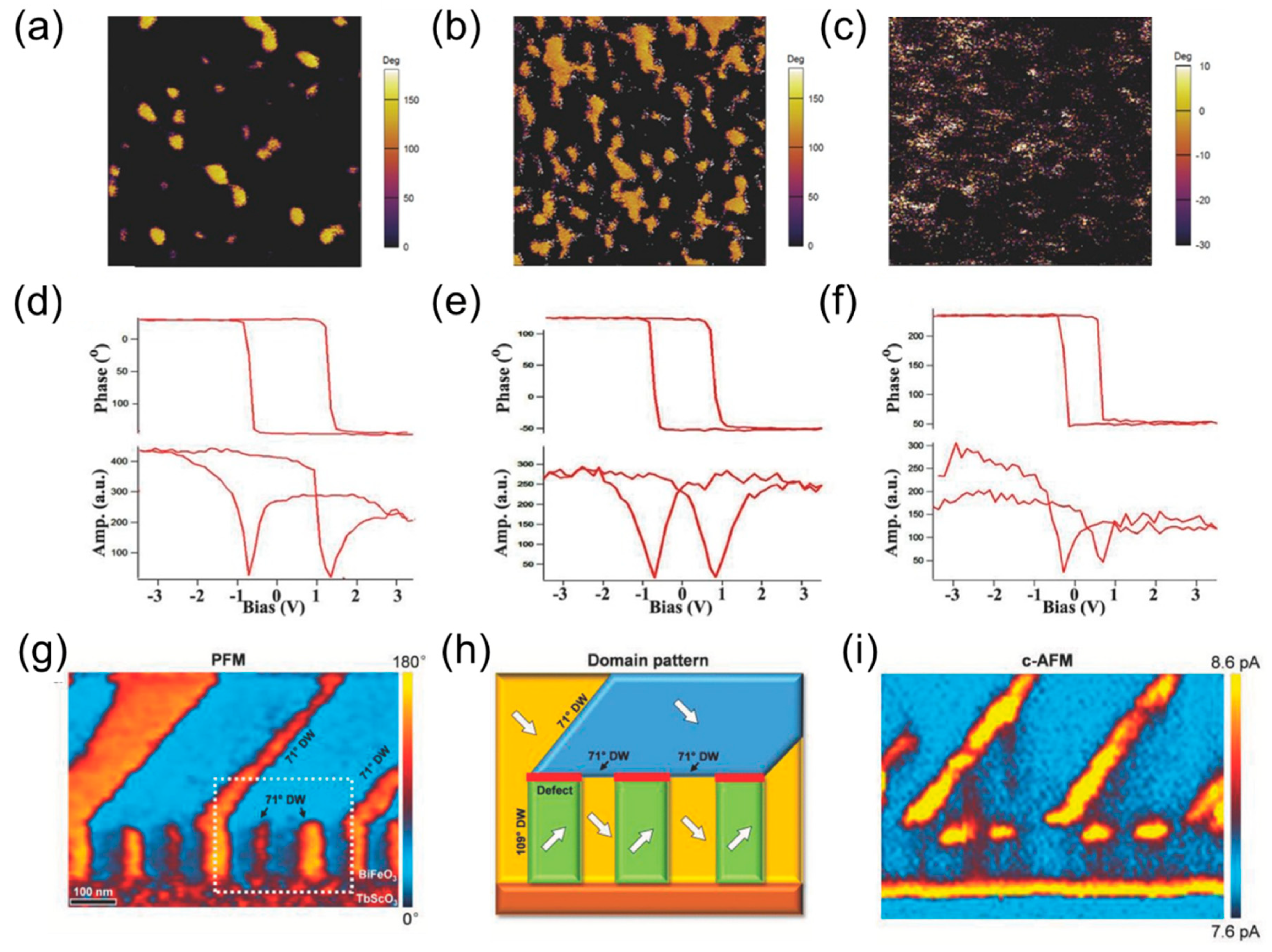
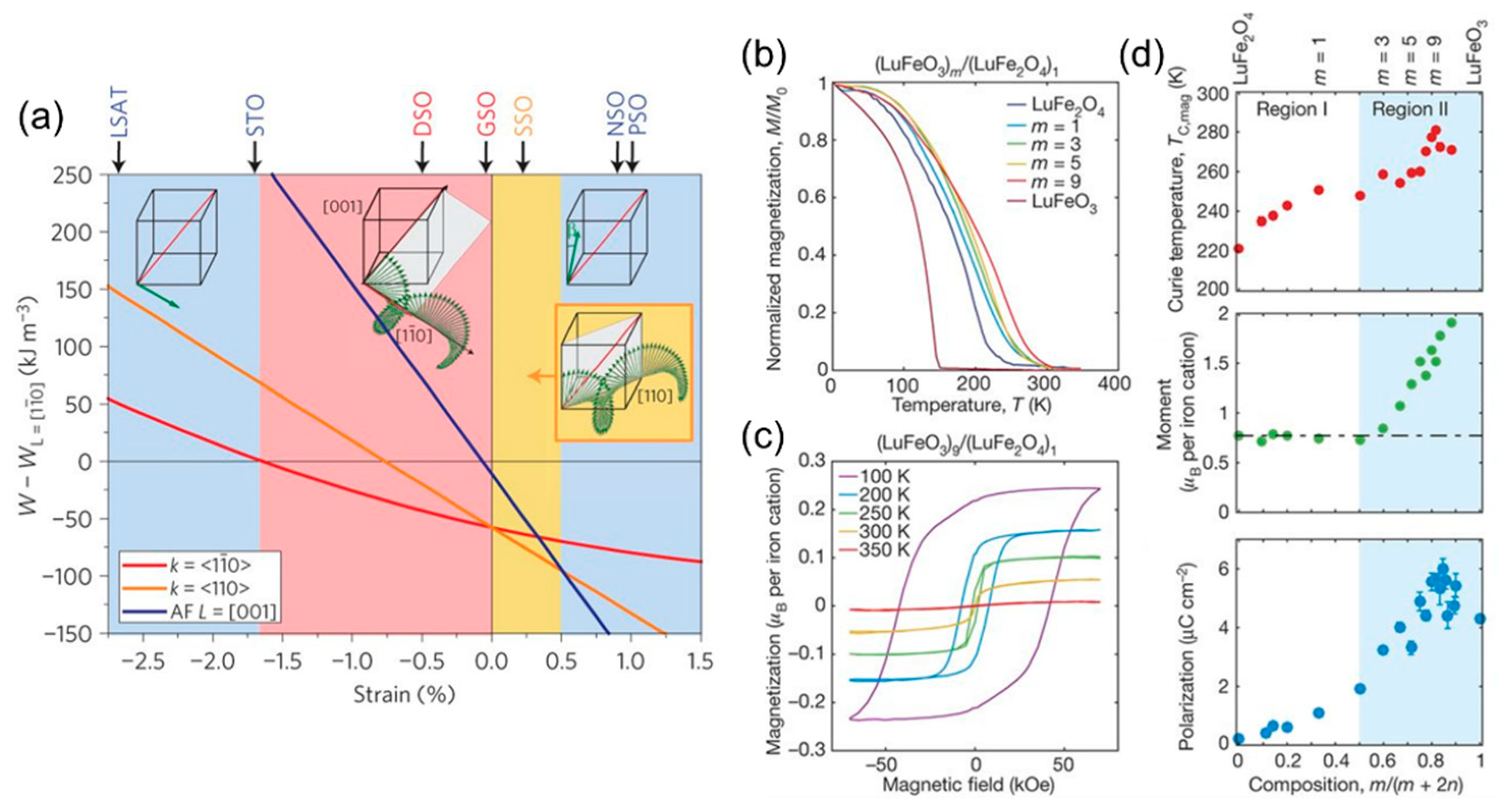
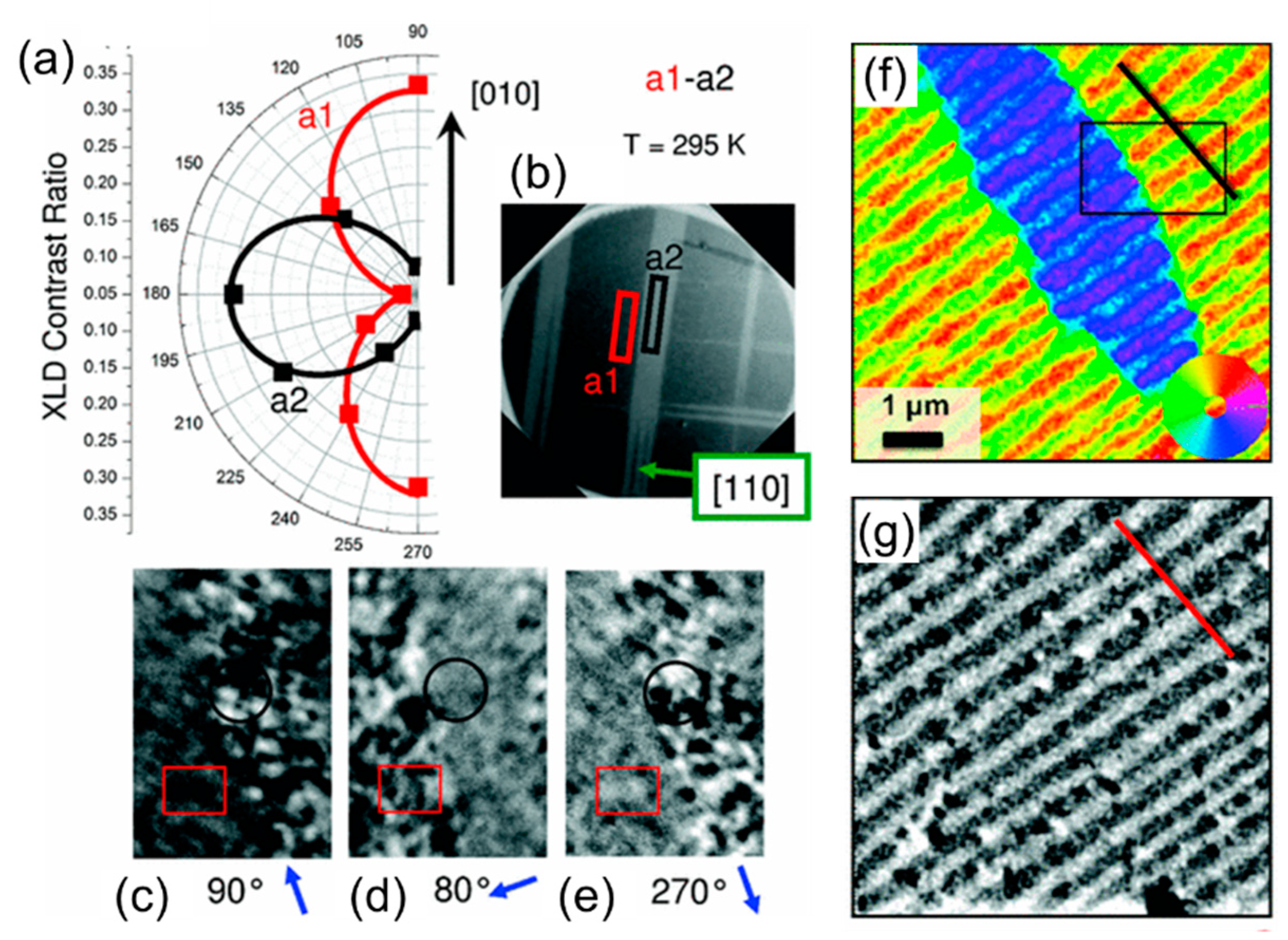
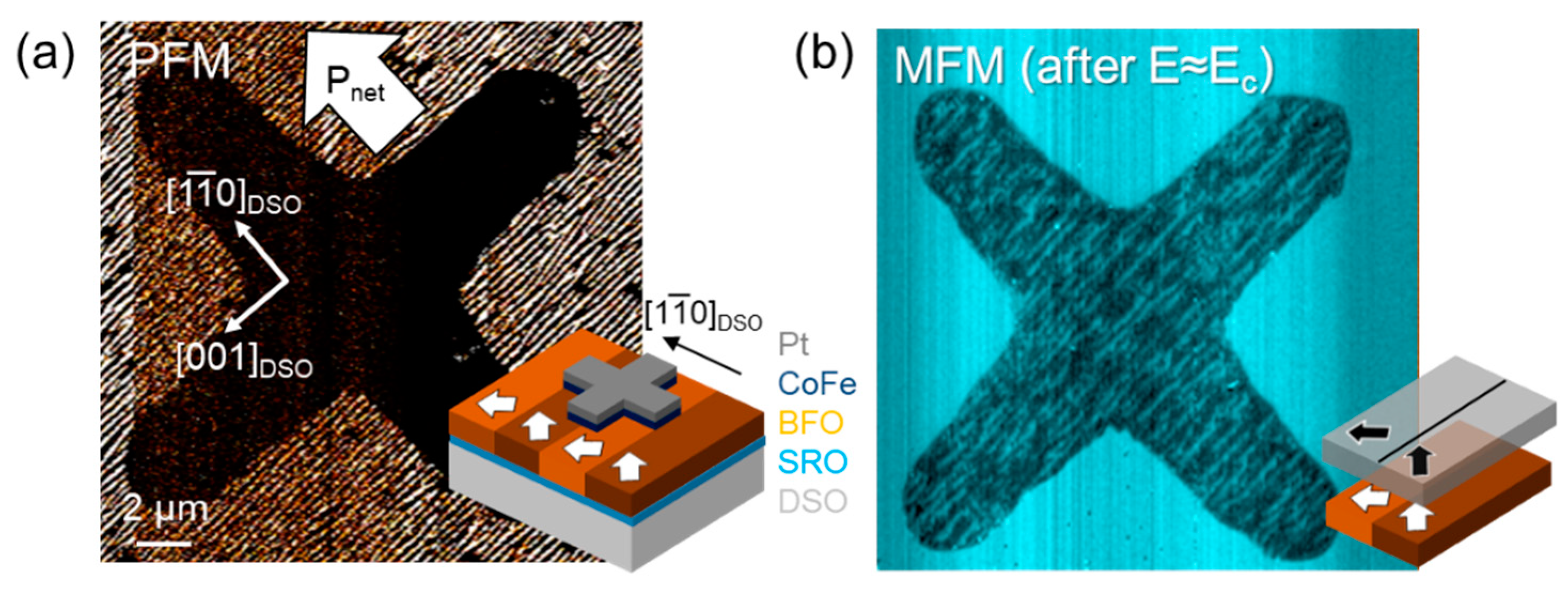
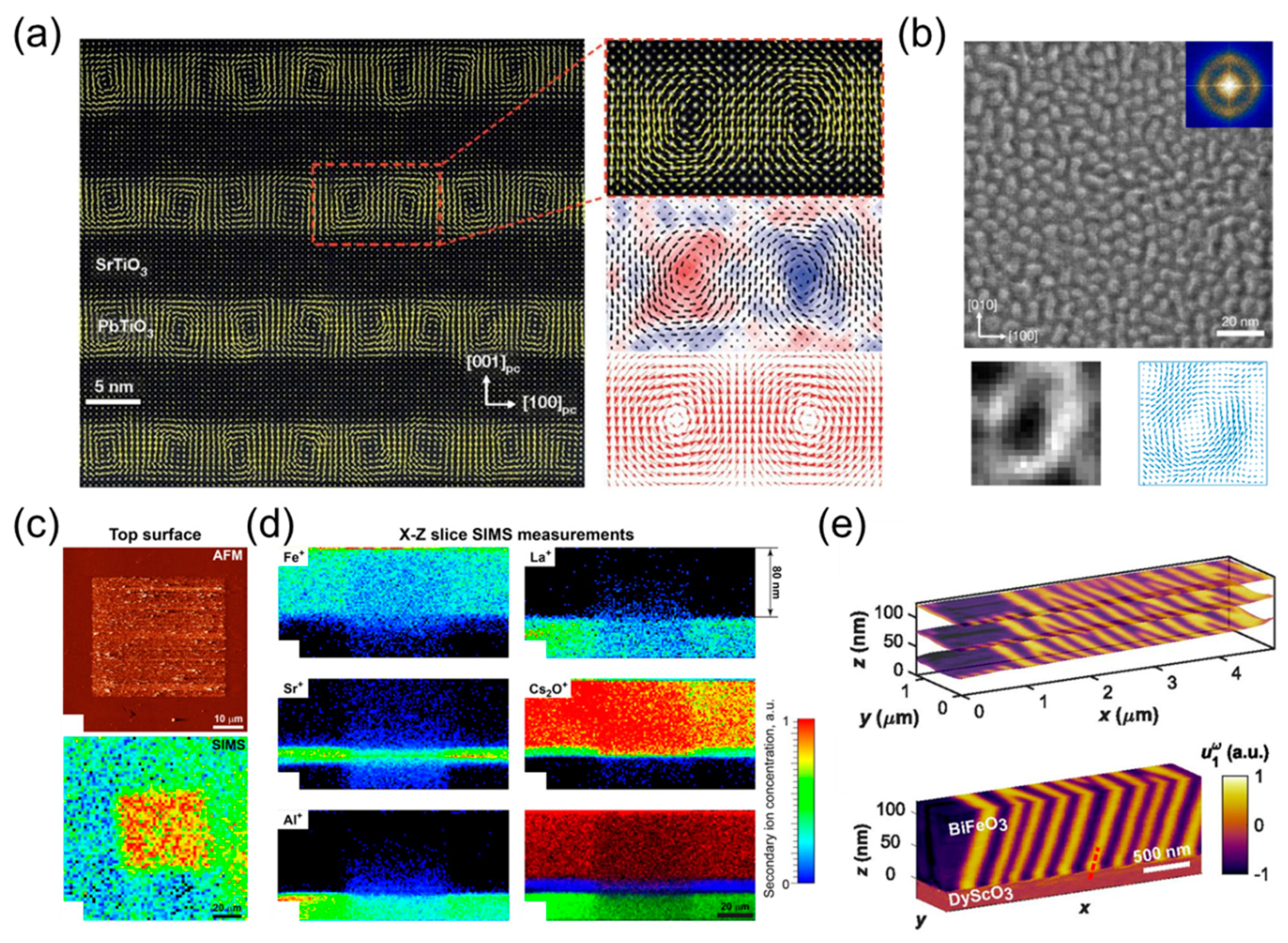

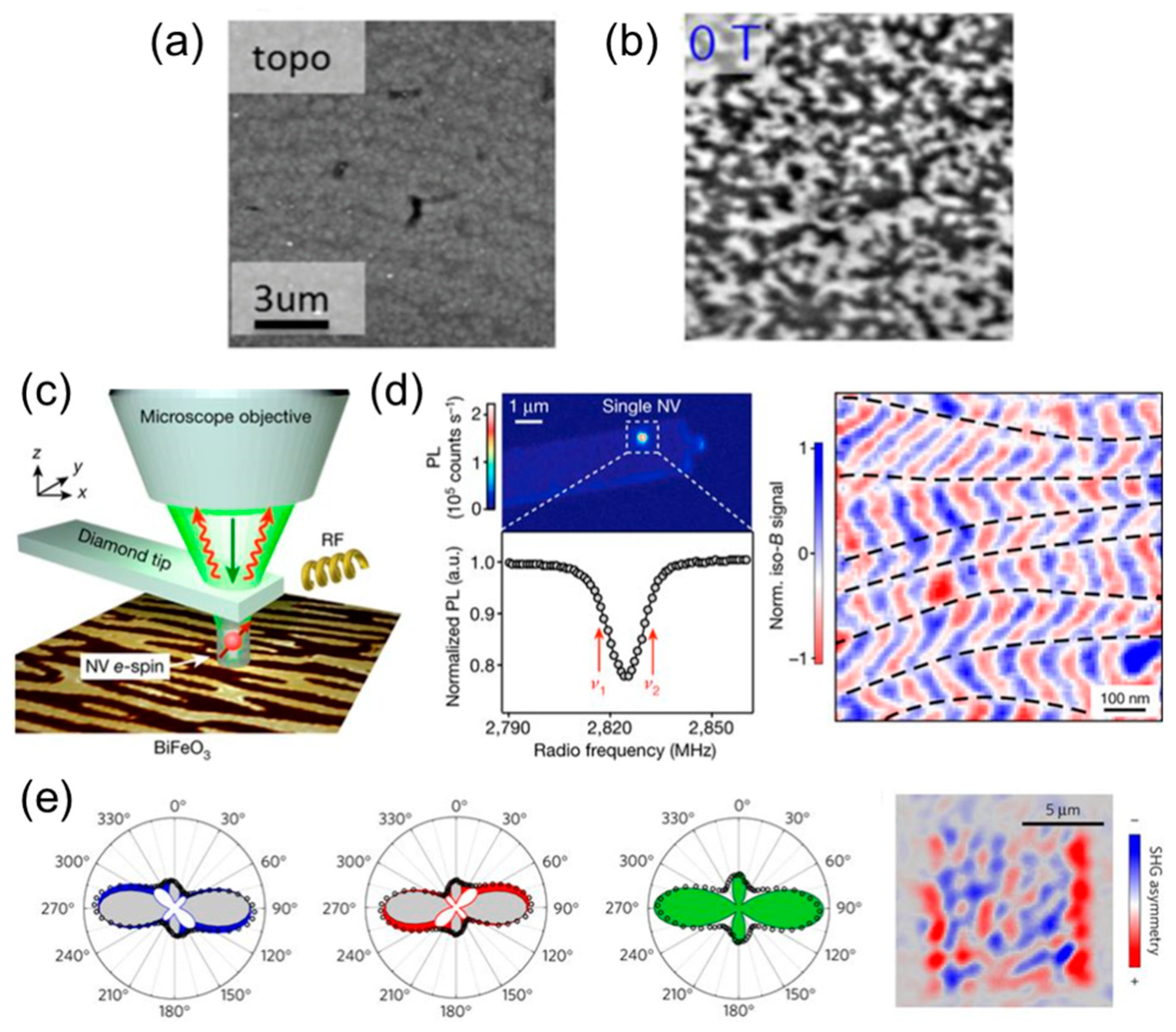

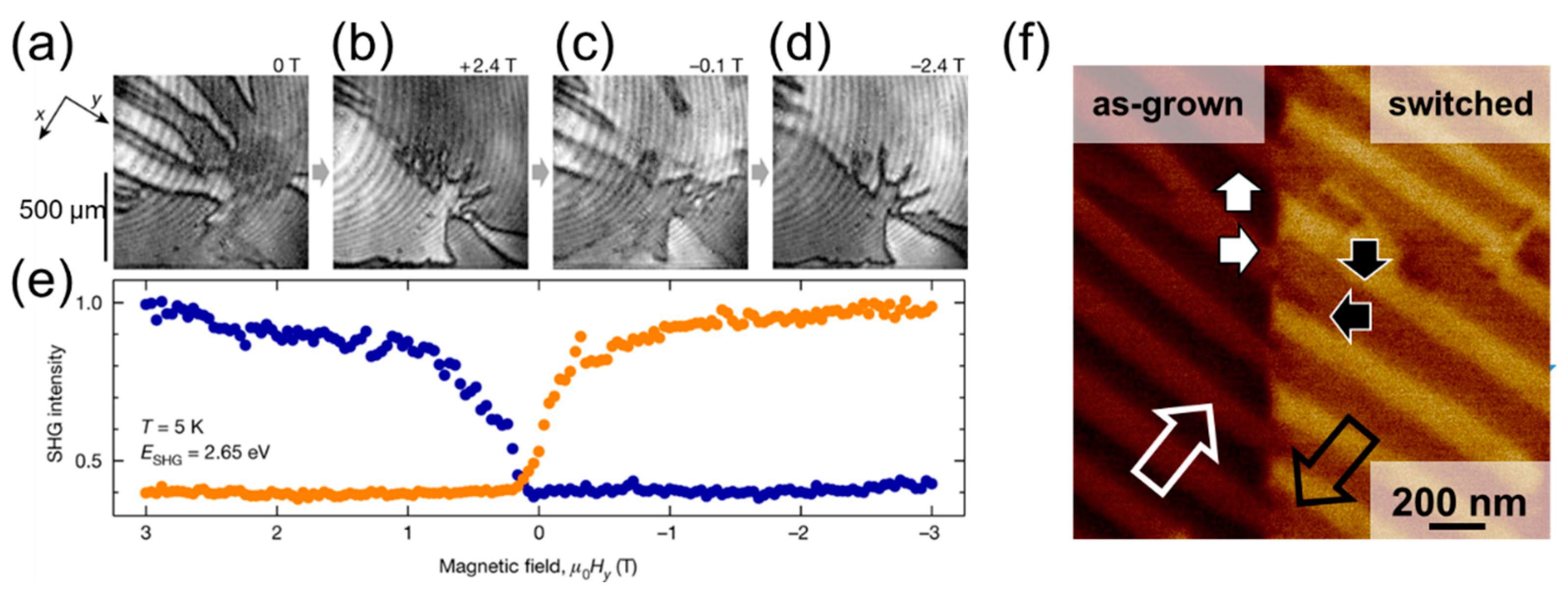
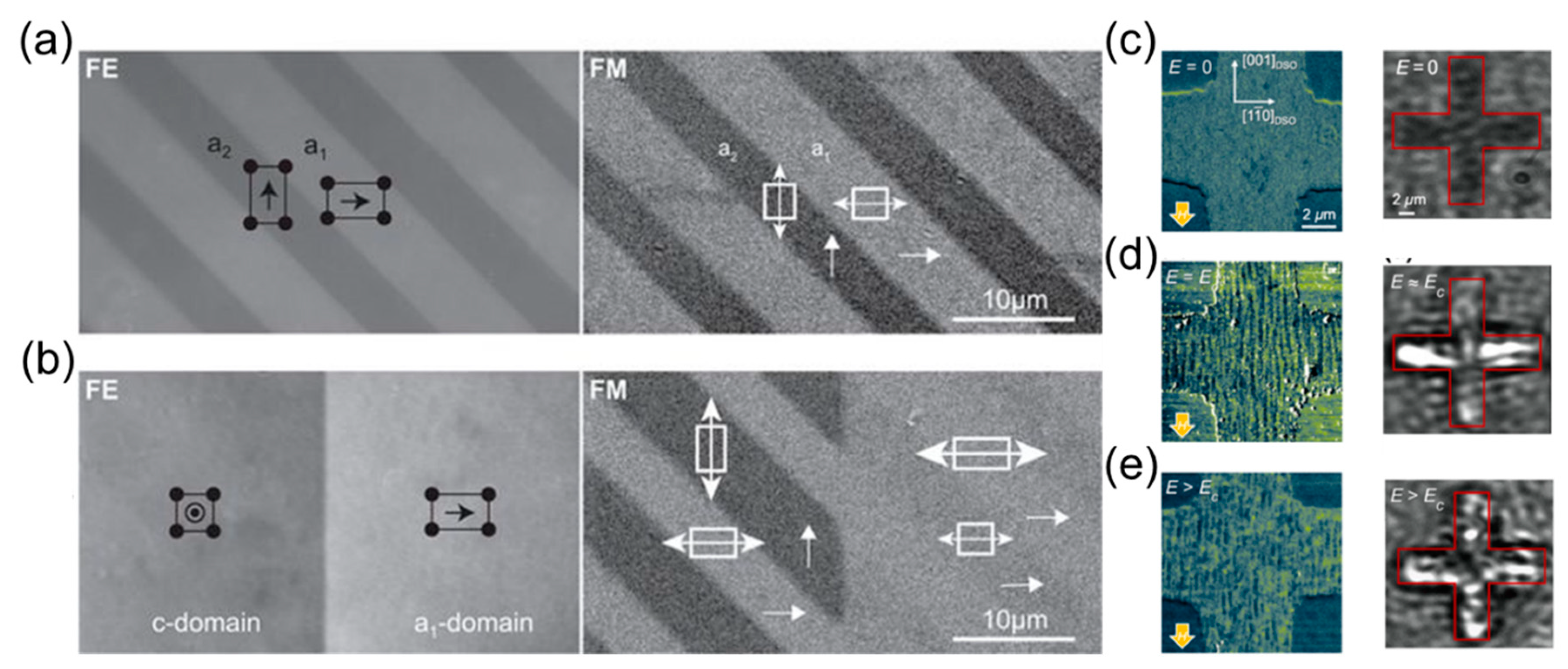
© 2019 by the authors. Licensee MDPI, Basel, Switzerland. This article is an open access article distributed under the terms and conditions of the Creative Commons Attribution (CC BY) license (http://creativecommons.org/licenses/by/4.0/).
Share and Cite
Strkalj, N.; Gradauskaite, E.; Nordlander, J.; Trassin, M. Design and Manipulation of Ferroic Domains in Complex Oxide Heterostructures. Materials 2019, 12, 3108. https://doi.org/10.3390/ma12193108
Strkalj N, Gradauskaite E, Nordlander J, Trassin M. Design and Manipulation of Ferroic Domains in Complex Oxide Heterostructures. Materials. 2019; 12(19):3108. https://doi.org/10.3390/ma12193108
Chicago/Turabian StyleStrkalj, Nives, Elzbieta Gradauskaite, Johanna Nordlander, and Morgan Trassin. 2019. "Design and Manipulation of Ferroic Domains in Complex Oxide Heterostructures" Materials 12, no. 19: 3108. https://doi.org/10.3390/ma12193108
APA StyleStrkalj, N., Gradauskaite, E., Nordlander, J., & Trassin, M. (2019). Design and Manipulation of Ferroic Domains in Complex Oxide Heterostructures. Materials, 12(19), 3108. https://doi.org/10.3390/ma12193108




